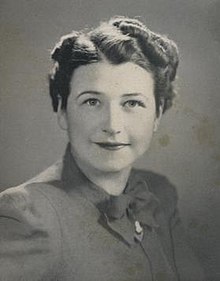Ruth Graves Wakefield
Ruth Graves Wakefield | |
|---|---|
 | |
| Born | Ruth Jones Graves June 17, 1903 |
| Died | January 10, 1977 (aged 73) |
| Education | Framingham State Normal School |
| Known for | Inventing the Chocolate chip cookie |
| Spouse |
Kenneth Donald Wakefield
(m. 1928) |
| Children | 2 |
| Culinary career | |
| Cooking style | American |
Previous restaurant(s)
| |
Ruth Jones Wakefield (née Graves; June 17, 1903 – January 10, 1977) was an American chef, known for her innovations in the baking field. She pioneered the first chocolate chip cookie recipe, an invention many people incorrectly assume was a mistake.[1] Her new dessert, supposedly conceived of as she returned from a vacation in Egypt, is the inspiration behind the massively popular Toll House Chocolate Chip Cookie.[2] Throughout her life, Wakefield found occupation as a dietitian, educator, business owner, and published author. She wrote a cookbook titled Ruth Wakefield’s, Toll House: Tried and True Recipes.[3]
Personal life
[edit]Ruth Jones Graves was born on June 17th, 1903, in East Walpole, Massachusetts, to Fred Graves and Helen Vest Jones.[1] She was raised in Easton, Massachusetts, and attended the Framingham State School of Household Arts, currently Framingham State University. Upon graduation in 1924, Ruth taught home economics at Brockton High School, in addition to working as a hospital dietitian and a customer service representative at a utility company.[4] Ruth married Kenneth Donald Wakefield, a meat packing executive, in 1928.[5] Together, the couple had two children, Kenneth Donald Jr. and a daughter, Mary Jane.[3] In 1930, the couple decided to purchase a historic building in Whitman, Plymouth County, which had allegedly been used as a toll house as early as 1709.[1] Building on the tradition of the house, Kenneth and Ruth elected to turn the building into a lodge, fittingly naming the new business the Toll House Inn.[6] The news of her cooking prowess quickly spread, as the inn grew from seven to over sixty tables.[4]
Toll House Inn
[edit]Wakefield and her husband bought a tourist lodge that they called the Tollhouse Inn.[7] They called it this because it was located on what used Bedford]]. Ruth cooked for the guests using her own recipes and some of her grandmother's old recipes that became very successful and grew the Inn's dining room from seven tables to sixty. Her recipes were so popular that she released multiple cookbooks, the most popular being a cookbook titled Ruth Wakefield's Tried and True Recipes in 1931.[4]
Inventing the "Toll House" Chocolate Chip Cookie
[edit]In 1938, Ruth Graves Wakefield invented the chocolate chip cookie, a lasting symbol of culinary creativity. While working in the kitchen at the Toll House Inn, she tried to improve her butter drop cookie recipe. She added chopped pieces of a Nestlé semi-sweet chocolate bar, expecting the chocolate to melt evenly into the dough. Instead, the chocolate held its shape, creating soft chocolate pockets in the cookie. She called this new creation the "Toll House Chocolate Crunch Cookie," and it quickly became a favorite among guests at the inn. (1)
The cookie’s unique flavor and texture became widely popular, bringing significant attention to the Toll House Inn. The recipe’s fame grew so much that Ruth included it in a revised edition of her 1931 cookbook, Toll House Tried and True Recipes. As demand for the recipe increased, Nestlé noticed and approached Ruth to form a partnership. In 1939, they made a deal where Nestlé could print her recipe on their packaging. In return, Ruth received a lifetime supply of Nestlé chocolate and $1 for the rights (1).
This partnership was a major moment in the baking world. Nestlé began producing pre-scored chocolate bars to make chopping easier and later introduced the first chocolate chips made for baking(5). What began as a simple experiment in the Toll House Inn kitchen became one of the most iconic desserts in history.
Toll House Cookies and World War II
[edit]The Toll House Cookies rose to popularity in 1940, during World War II. Ruth's daughter (who worked as a cooking assistant) recalls days in the kitchen filled with packing care packages to send to the Massachusetts troops overseas. They soon began receiving letters from all over the country requesting that the packages including Toll House Cookies be sent to troops from other states.
Death
[edit]Ruth retired in 1966 and sold the Toll House, which later burned down in 1984. Ruth died on January 10, 1977, in Plymouth, Massachusetts, at the age of 73.
References
[edit]- ^ a b c Roberts, Sam (March 22, 2018). "Overlooked No More: Ruth Wakefield, Who Invented the Chocolate Chip Cookie". The New York Times. ISSN 0362-4331. Retrieved December 6, 2023.
- ^ Geib, Claudia (April 21, 2022). "Contrary to What You've Heard, Toll House Didn't Invent the Chocolate Chip Cookie". Eater. Retrieved December 6, 2023.
- ^ a b CooksInfo. "Ruth Wakefield". CooksInfo. Retrieved December 6, 2023.
- ^ a b c Kelly, Kate (November 20, 2013). "Chocolate Chip Cookie Inventor: Ruth Wakefield (1903-1977)". America Comes Alive. Retrieved December 6, 2023.
- ^ Harkin, Sofia (December 11, 2020). "Ruth Graves Wakefield Biography for Kids". Lottie. Retrieved December 6, 2023.
- ^ "Ruth Wakefield". Lemelson. Retrieved December 6, 2023.
- ^ Babwa, A. (January 29, 2007). "Who is Ruth Wakefield?". Northeastern University. Retrieved July 29, 2024.
